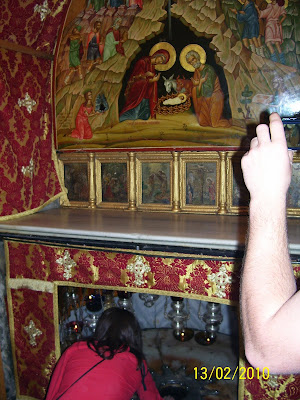




Part of our semester duties is to prepare bus lunches for the field study trips. And since we get to particpate in the "Physical Settings" class trips . . . we made enough for us, too! We got up early last Saturday, 13 Feb, and prepared breakfast for everyone. Yehye served those students who were not going on the trip, and cleaned up for us. We joined the class and walked to the Jaffa Gate where we boarded at 7am and started our study on nearby Mt. of Olives, where we ourselves had been before. On this trip we visited the Greek Orthodox Church with it's impressive goldplated onion domes, which we only saw from a distance on our earlier trek to the Mount (see pics on earlier Mount of Olives post).
We learned from Dr. Wright that what we see does not necessarily always line up historically. For instance, what we originally thought was Absalom's Pillar is actually a tomb for a temple priest, and the traditional site of the Garden of Gethsemane is probably not the spot where Jesus prayed. The grove of olive trees at this site are at most only 800 years old, as the originals would have been utilized along with all other area trees as firewood during the Roman siege in 70AD. But nothing changes biblical facts. We do know that Jesus did spend much time on the Mt. of Olives, and he did pray somewhere up there before being betrayed by Judas, arrested by the Romans, and taken across the Kidron Valley to Jerusalem for trial. Local and church tradition, we see now, are always to be questioned.
We went to Herodian (Herodium), one of perhaps as many as twelve palaces commissioned and built by King Herod the Great. Most were built from 20-10BC (industrious fellow) in locations such as Caesarea (including a port formed by a seawall which he was told would be an "engineering impossibility;" the guy really liked a challenge), on the coast of the Mediterranean, on Jerusalem's Temple Mount, in Jericho, and on the mountain fortress of Masada. We are eagerly anticipating our trip there.
Herodian is a very impressive site. It has a breathtaking view overlooking the Judean Desert and the mountains of Moab (now in Jordan) to the east, and the Judean Hills to the west. It was built in two separate areas, each with a distinct function: a circular fortress, including an elaborate palace, surrounded by a wall with towers on top of the hill; and Lower Herodium, in the plain to the north, with a group of royal buildings around a large pool.
The combination of fortress and palace is a uniquely Herod innovation, which he repeated on Masada. At Herodian, a circular palace-fortress was constructed on top of a hill, which rises almost 200 feet above its surroundings. The outer walls measure about the same in diameter. The fortification was originally about 100 feet high, with seven stories. Two of these stories were underground foundations, strengthened with barrel-vaulted ceilings, and the superstructure of five stories was considerably higher than the palace courtyard. Wooden ceilings separated the stories, which were used for storage and as quarters for soldiers and servants. Huge towers projected from the walls on all four sides. The eastern tower (the largest) was a massive, round tower on a solid stone base and measured approximaely 60 feet in diameter. It had several upper stories with elaborate rooms, probably for the use of the royal entourage. This eastern tower rose above the entire fortress, its roof commanding a panoramic view; it also served as a hiding place in times of danger. There is a current archeological dig in progress because Herod's tomb was discovered in Herodian in 2007.
On our drive to Bethlehem, we passed through the area where Naomi & Ruth would have moved to after Naomi's husband and two sons died (one being Ruth's husband). We stopped and took a few photos at a threshing floor, not unlike the one where Boaz & Ruth "met".
In Bethlehem, we visited the Church of the Nativity where Dr. Wright says is very probably an accurate location for Jesus' birthplace. http://en.wikipedia.org/wiki/Church_of_the_Nativity
Once inside the church, we followed the crowd into the "grotto" where a silver star marks the spot. Israelis are not allowed in Palestinian controlled Bethlehem since the second intifida which began in September 2000. In mid 2002, Israel built a long, 25 ft. high concrete wall separating it's capital Jerusalem from Bethlehem. Israeli's call it a security wall to prevent suicide bombings and terror attacks. Palestinians call it the apartheid wall. We can see it from Mt. Zion. We didn't have much time to sightsee this day, so Nat & I plan to return soon on our day off. We'll catch Bus #21 at the Damascus Gate and it will drop us off at the checkpoint entrance to Bethlehem.
http://en.wikipedia.org/wiki/Second_Intifada has a photo of the wall. We were not allowed to take any pictures as we passed through Israeli security on our return to Jerusalem from Bethlehem. My, my how things have changed since the Prince of Peace was born in that little town.
We do wonder if Joseph & Mary stopped for a "Stars & Bucks" latte on their way to the inn?
Shalom y'all

1 comment:
We do wonder if Joseph & Mary stopped for a "Stars & Bucks" latte on their way to the inn?
If they did I'm sure Mary would have ordered a caffeine-free beverage.
It is amazing to think that you visited the place that is the probable location of Jesus' birthplace.
Post a Comment